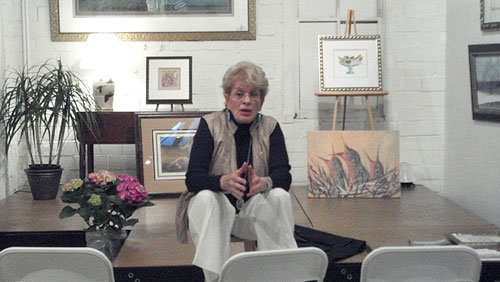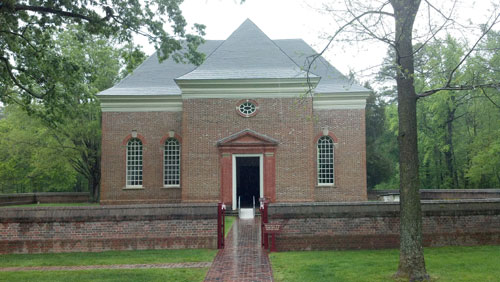
Dear Friends:
Last Thursday evening I was the guest speaker at Gloucester Arts on Main, in Gloucester, Virginia. It was a great joy to be there, and I was invited to come back Saturday night to hear members of Lyric Opera Virginia perform selected songs from the opera Carmen. The performance was so beautiful and professional, and what a joy to have such quality entertainment so close by. There were people from Mathews and all around in the audience, and many of them were collectors of my work and recognized me. This was Lyric Opera Virginia’s second performance at Gloucester Arts on Main, and I hope they will come back and do many more. I want to be there for any performances they have!
Giving my talk at Gloucester Arts on Main last Thursday night.On Sunday, we attended church at Historic Christ Church in Lancaster County, Virginia. My daughter Patty’s friend Mary is a member of the Kilmarnock & District Pipe Band, which had been invited to perform during the church’s annual Kirkin’ o’ th’ Tartan ceremony. It was an inspiring service, and many in the congregation wore tartans. The way I understand it, the origins of the Kirking of the Tartan are believed to date from the 1700’s when, after the Battle of Culloden in 1745, the English attempted to break the Scottish clan system by banning, under pain of death, the wearing of tartans and the playing of bagpipes. As a form of resistance, Scots would hide bits of tartan on their person when attending the kirk (church). In this way, when blessings were offered, the tartan and, by extension, the clans and families were blessed. The service eventually became a Scottish American tradition. The common thread in each of the thousands of services conducted each year in all parts of the country is the opportunity to dedicate to Almighty God the tartan symbol of unwavering loyalty, steadfast faith, rugged individualism, and regard for human personality.
Christ Church in Lancaster is the best preserved of colonial Virginia’s Anglican parish churches. It is the only church from colonial Virginia to retain its original high-backed box pews, and it is one of only two with its original triple-decker pulpit. It was designated a National Historic Landmark in 1961. A church has stood in that particular spot for more than 300 years. The first church constructed there, most likely wood-framed, was built under the direction of John Carter and finished in 1670. In 1730, John’s son Robert “King” Carter, colonial Virginia’s most prominent planter, proposed to build a brick church at his own expense, which the vestry of Christ Church Parish accepted. The church was finished in 1735.
Historic Christ Church, Lancaster, Virginia, c. 1735.The first time I visited the church was in 1996, and I subsequently created a print edition titled Christ Church. There is a Visitors’ Center on the grounds now that wasn’t there before. It’s a beautiful church, well off the beaten path, and going there is like stepping back in time.
Well before the Pilgrims stepped onto Plymouth Rock and centuries before Ellis Island was a hub for immigration, the Tidewater Region of Virginia was being colonized by the English with the establishment of Jamestown in 1607 by the Virginia Company of London, which was a profit-seeking business venture governed by stockholders. When the company went bankrupt in 1624, its charter was revoked by King James II, and Virginia was ruled as a royal colony of the King until the American Revolution. As more and more colonists sought their fortunes and freedom in Virginia, more land was needed and they spread out from Jamestown. Lancaster County was formed from Northumberland and York Counties in 1651. Most place names in the region duplicate English cities and towns, and Native American names are also represented. Many people living in the region are descendants of English colonists and still speak with a trace of an English accent. Mathews County, where I live, shares this rich heritage.
I’ll be heading up to Waynesboro later this week for the opening of the P. Buckley Moss Invitational Art Show on Thursday evening at 6:00 p.m. at the Moss Museum. Earlier that day, I’ll choose the “Grand Prize Winner,” which will be announced later that evening. Art students from area schools have been invited to participate in the show, and there will be prizes awarded in different categories. The judges of the various media are:
Textiles: Rachel W. N. Brown, owner of Rachel’s Quilt Patch, Staunton, Virginia
Sculpture: Jon Thames, McGuire Fine Arts in Frederick, Maryland
Painting & Print-Making: Piper Grove, Shenandoah Valley Arts Center
Photography: Lynn Conyers, a photographer and former teacher
Drawing: Ken Schuler, a local artist
Mixed Media: Janet Doerr, a local artistThe show will be on display April 26-May 26.
Come join us for spring in The Valley this weekend! I’ll be there from Thursday through Sunday. My Musuem Open House and Barn Show is Friday through Saturday, and we’ll release my latest print of Bushong Farm, located in the Shenandoah Valley outside the village of New Market. The famous Battle of New Market was fought all around Bushong Farm on May 15, 1864, and this painting was created in honor of the Sesquicentennial Anniversary of the War Between the States.
Homage to the Past will be released as a giclée on paper during my Museum Open House and Barn Show, April 27-29. For more information, please contact the P. Buckley Moss Museum at 1-800-343-8643 or 540-949-6473.I’m looking forward to seeing you!
Love,
Pat
P. Buckley Moss Galleries, Ltd
74 Poplar Grove Lane
Mathews, VA 23109
(800) 430-1320
©P. Buckley Moss 2012


